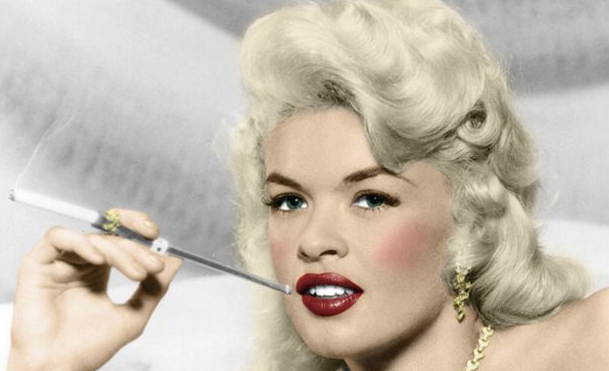Jayne Mansfield may very well have been one of the first emblems of life in a postmodern world. Thus, her strong presence throughout Don DeLillo’s historically sweeping Underworld is nothing if not natural (a strange word choice when alluding to Mansfield). Indeed, there are quite a few nods to major personas of the twentieth century, including J. Edgar Hoover and Lenny Bruce. But there is something more specific about the way DeLillo hones in on Mansfield’s aura of garishness that so perfectly encapsulates everything that was simultaneously great and flawed about postmodernism.

Klara, an artist and anti-heroine, finds herself the Monroe to her friend Acey’s Mansfield. A fellow artist who isn’t as talented but has received much media attention of late, Acey feeds into the allusive nature of Underworld by making Mansfield the central focus of her new art exhibit. In explaining her reasoning to showcase Mansfield, she states, “’I wanted a packaged look. I didn’t want Monroe, I wanted Mansfield. All bloated lips and total boobs. I mean it was so obvious and it took me fucking forever.’ ‘Have I ever seen a Jayne Mansfield movie?’ ‘Nobody has. Doesn’t matter. She was uncontainable in a movie,’ Acey said.” And this is largely true. Most people can identify who Mansfield is, but not anything she’s been in. This strange phenomenon relates back to how our culture has a predilection for rendering its memory as murky and malleable as possible for the convenience of reacting anew.
DeLillo also explores the idea, through the voice of Acey, that the concept of modernism essentially ceased to exist when the original Jayne—Marilyn—died. Acey insists, “‘…the minute Marilyn died all the other sexpots died with her. They were like philosophically banned from existing. Jayne outlived Marilyn by only five years and for about four and a half of those years she was bummed-out, washed-up, beat up by husband number whatever-he-was and there was nothing left but exploitation movies and heavy drinking.’” Once again, DeLillo proffers the notion that the ultimate underworld of American society is the recycling of pop culture, repackaged to make more profit under the guise of newness. The recycling element correlates with Nick’s profession in waste management as well.

Another analysis of Mansfield’s persona comes in the form of comparing her self-love to Monroe’s self-hate. The irony in the knockoff version being more comfortable with herself pertains to the confidence of being American in the mid-twentieth century; it entailed an utter belief in being able to reinvent oneself as a bigger and better version of someone else. Acey elaborates, ‘”See Marilyn hated being Marilyn. But Jayne loved it… She was born to be Marilyn. She lived in a pink palace that had a sizable zoo. And the way these things happen, the discount sex queen becomes famous and famous and famous and finally she’s the most photographed woman in the world.’” The clincher on the argument concludes with “…you have copycat Jayne, the reproduced goddess, and she is all the more strong for being unoriginal.”

Eric hid the rubber in his room, pressed into a box of playing cards. He took a long look at Jayne Mansfield’s picture before he slipped it into the world atlas on his desk. He realized that Jayne’s breasts were not as real-looking as he’d thought in his emotionally vulnerable state.”
While Underworld encompasses innumerable aspects of Americana—it is, after all, one of the last “great American novels”—it is Jayne Mansfield as a construct that most effectively serves to summarize it all.




















